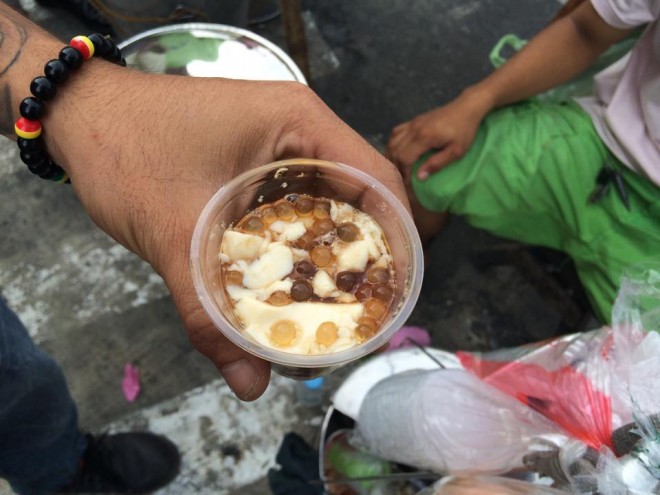
Taho is a staple Manila street food. We see it every day, but rarely do we think about how this treat finds its way into our mornings.
At least I didn’t, until I spotted a man biking with the iconic silver container on his back one evening. Curious, I pulled up next to him and awkwardly asked the obvious: Was he a taho vendor?
At first he was a bit weirded out by my inquisition. Where was he coming from? Was the container empty? How many cups had he sold? Was it heavy? Did he like taho or hate it? How far did he bike every day? I peppered him with questions until the light turned green.
Edwin was coming from his route around the Mall of Asia. He loved taho and enjoyed vending as a livelihood. He biked every day and on weekends rode with his friend to Manila Bay or out of town as far as Tagaytay or places further afield in Rizal.
He was headed home to Makati, but planned to stop first to reserve the next day’s stock at his taho supplier off JP Rizal. He had such a positive disposition that I felt confident enough to impose myself further by asking if I could shadow him as he ran his errands.
We exchanged tips on best biking routes and figured out he was from my dad’s province up north. We biked side by side, annoying all cars in our path. I was enjoying our evening ride together, but when we arrived at the taho “factory,” I started to question my adventurous impulse.
Deep pots
We pulled our bikes in front of what seemed to be a regular two-story row house; a wooden frame with ironwork window grills typical of residential neighborhoods in the city. The first floor was open to the street without a door and several characters were hanging around the unlit entrance. They all wanted to know: “What’s she doing here?”
Once inside, I came face to face with two cooks, both in their boxer shorts, busy stirring a row of deep pots; a dark substance bubbled over the LPG flames. On another side of the room, a tiny sliding glass window framed a surly, thin-faced man typing away on a cell phone.
I tried to avoid direct eye contact. Walking further in, I had to step over people playing card games on the floor of a narrow hallway.
In the back room, a worker dutifully mopped a tile floor lined with blue water drums; thick layers of hard soy crusted to the edges of the round openings. Already done mixing the day’s batches, the mopper reenacted for me how he stirs the tofu in a metal tub with a tool the size of a shovel.
The taho tins, shaped like metal garbage pales, hung in rows up the wall to the ceiling.
If I weren’t familiar with this popular breakfast snack, I would have thought I’d walked into a totally different kind of operation.
Upon closer inspection, the details came into focus. In the big pots, brown sugar was boiling down with bundles of fresh pandan leaves to make the sweet syrup that brings the silky soft tofu to life. A sign taped to the sliding window by the angry looking man simply listed the price of sugar, sago and tofu by weight.
I learned that many of the “characters” outside were vendors employed by the factory who also lived in dorms on the other side of the hallway. Like most informal enterprises in the city, the owners lived upstairs.
Independent vendor
Edwin is an independent vendor and travels to these types of suppliers all over Metro Manila to purchase a tin full of tofu and its sago and syrup condiments. His investment totals about 200 pesos, and at 10-20 pesos per cup size, he can make up to 750 pesos each day. He pays a small boundary fee depending on the territory and he saves on transportation by using his bike.
The network of factories allows him to easily move around the city, try new markets, and adjust his routes to demand, or other factors like weather. The informal economy impresses with its ability to respond to needs on the ground and find real-time solutions. Operating on its own rules, it can narrow in on opportunities in ways traditional business models cannot.
I still don’t grasp how it all works. I’ve tried to balance the tins on a bamboo pole over my shoulders and could barely take two steps. I wonder how new vendors find these networks and figure out where to sell.
Some things are probably better left a mystery, like what do they do with the leftovers, or how long has the vat of soy been sitting there?
But I am fascinated by these invisible systems pumping under the surface of our city. They show me that the city is growing and thriving at a rate and scale we often won’t fully comprehend.
Now when I hear the drawn-out “tahoooooo” call on my morning commute, I look around to see what other surfaces I should scratch.